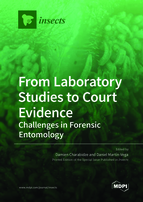From Laboratory Studies to Court Evidence: Challenges in Forensic Entomology
A special issue of Insects (ISSN 2075-4450). This special issue belongs to the section "Role of Insects in Human Society".
Deadline for manuscript submissions: closed (28 February 2021) | Viewed by 74889
Special Issue Editors
Interests: forensic entomology; Calliphoridae; ethology; sociality; law history
Special Issue Information
Dear Colleagues,
In 2001, Benecke concluded a review on the history of forensic entomology with these optimistic words: "basic research and advanced application of forensic entomology (…) has opened the way to routine casework" [1]. At the same time, the TV show Crime Scene Investigation (CSI) largely brought forensic entomology to light. However, the show also cruelly pointed out its limits: After explaining to his colleague how insects can help in determining the time of death, the team leader added "You've still got to convince a jury", to which the colleague promptly responded "On guns. It's got to be better than bugs. Less Latin" [2]. Indeed, several factors—including complexity, inherent limitations, and rapid evolution of scientific knowledge—explain the slow acceptance of insect-based evidence. In this context, this Special Issue will focus on the articulation between laboratory studies and casework, a major challenge for the future of forensic entomology.
[1] Benecke M. A brief history of forensic entomology. Forensic Sci. Int. 2001, 120, 2–14.
[2] Episode 1.10. Sex, Lies and Larvae.
Dr. Damien Charabidze
Dr. Daniel Martín-Vega
Guest Editors
Manuscript Submission Information
Manuscripts should be submitted online at www.mdpi.com by registering and logging in to this website. Once you are registered, click here to go to the submission form. Manuscripts can be submitted until the deadline. All submissions that pass pre-check are peer-reviewed. Accepted papers will be published continuously in the journal (as soon as accepted) and will be listed together on the special issue website. Research articles, review articles as well as short communications are invited. For planned papers, a title and short abstract (about 100 words) can be sent to the Editorial Office for announcement on this website.
Submitted manuscripts should not have been published previously, nor be under consideration for publication elsewhere (except conference proceedings papers). All manuscripts are thoroughly refereed through a single-blind peer-review process. A guide for authors and other relevant information for submission of manuscripts is available on the Instructions for Authors page. Insects is an international peer-reviewed open access monthly journal published by MDPI.
Please visit the Instructions for Authors page before submitting a manuscript. The Article Processing Charge (APC) for publication in this open access journal is 2600 CHF (Swiss Francs). Submitted papers should be well formatted and use good English. Authors may use MDPI's English editing service prior to publication or during author revisions.








